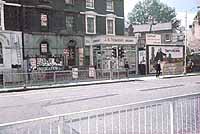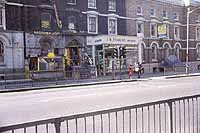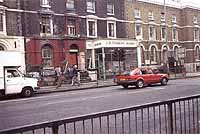20 Slideshows



Whereas some sites were selected almost because of their averageness and anonymity, one or two chose themselves by virtue of the curiosity they aroused. Chief of these is the premises of Dennis Noble, which, when I first came to live in the area in the early sixties, was the more or less straightforward business of a wedding and portrait photographer. Gradually his enterprise became more and more eccentric ...
We take up the story, as they say, when in 1973 there is still clear evidence, in the form of a now slightly chaotic window display, of Dennis Noble's professional practise. Even the scattering of subsidiary notices are still much to do with photography.
If some sites could be called ruminative this particular site is frantic in its activity and the gaps between our photos only capture a handful of the bewildering changes in decor and epigraphy. We miss for example the moment in 1985 when the shop was briefly festooned with greenery (in a passing role as a plant and shrub nursery) or, even more striking, when for a large part of 1977/78 it advertised itself as a hotel called (improbably enough for the area) Lakeside Residence: D. N. ran out space when writing the signboard for the hotel and it read, for a month or two, 'Lakeside Reside'. The hotel phase gave way immediately to a restaurant venture in which 'Polish Cuisine' was advertised with meals at 11 per head. I regret my cowardice in not having attempted to dine there. In the slide for 1978 dual evidence of the catering project remains in the notice offering 'PINT TEA' in the window (in this slide we catch a glimpse of Dennis Noble himself who seems often to be around at this time of day and appears in several of our photographs).
An obsession with bells is a recurrent feature with notices (STOP BELLS) directed against the neighbouring Parish Church and (STOP THIS BLEEP NOISE GLC) against the Pelican crossing outside. Other notices threaten to rival our own project (SITE FOTS.) or offer surprising services (e. g. COMEDY RADIO SCRIPTS WRITTEN - and, in 1988, ECOLE-VOIX).
Dennis Noble also has an unerring sense of colour as demonstrated in the various repaintings of his facade. After an extended blue period he has recently entered a Rothko-like Maroon phase with interim variations as in the green and yellow scheme of 1980.
Ingenious ways are found by which to announce the number (72) of the premises. The huge numbers 7 and 2 which flank the entrance in 1985 and which disappear in 1986 only, to make a comeback in 1988 are succeeded in 1989 by a variation (in a roundel) in the form of a would-be Roman VII-II. In 1991 it is mysteriously, renumbered 72 B.
As if the vagaries of Dennis Noble were not enough to follow there is action elsewhere in this view, most dramatically in the sudden appearance in 1974 of a surprise terrace of Georgian offices which make the sequence seem to leap back in time. These were named 'Georgian House' in 1975 but failed to find a buyer until 1978 when they were taken over by Council's Welfare Department Area 7 and lost their name, probably for ever.
Tomkins the next-door ironmongers is mercifully restrained and, apart from a reticent Jubilee display, changes little. On the right we have a headquarters of the Transport and General Workers Union which occasionally features political injunctions viz NO,NO,NO, in 1975 re the Common Market Referendum; advice which I am not sure I was wise to ignore.




















































